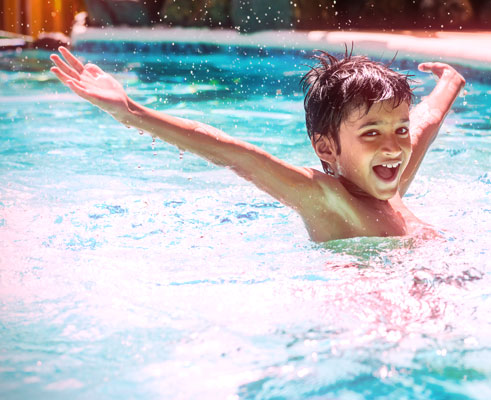
The National Center for Injury Prevention and Control states that drowning is the lead cause of accidental death in the U.S among children under five years old. Water safety is not only simple, but saves lives.
It is important to not only educate yourself on water safety, but taking the time to educate your entire family, water safety can save lives! If only one person in each family knows about water safety, it doesn’t help to prevent drowning.
All Eyes and Ears
Children can drown in just two inches of water and the time it takes to answer a phone call or use the restroom.This means that not only do you need to be watching your children, you need to be ACTIVELY watching and listening for your children.This means to be within arms reach of your child and never letting them leave your sight and refraining from being on the phone while watching your child. It only takes seconds for your child to sustain an injury or drown.
Never Alone
Never allow your child or children to swim alone. This means a parent should ALWAYS be there to watch actively. This also means that if a child is swimming with another child, that still is not enough. A child can not actively watch another child swimming in any circumstance. This is a reminder that parental supervision is the only way your children should be allowed to swim. Floaties also are not a substitute for parental supervision and give a child a false sense of security, they can pop, fall off etc.
Hyperventilating
Children and new swimmers can sometimes mistake getting ready to swim under the water with needing to hyperventilate and hold their breath. Remind children that they do not need to “practice” taking in deep breaths over and over again at any time near or in water.
Games

Make sure that children playing water games are not only safe to do in the water, but are safe for their swimming ability. For example, children should never have a contest to see who can hold their breath the longest. This is never safe, especially in a pool or near a body of water. Diving is another activity that children often like to do into pools. Make sure that children know where diving is safe and if they have the right ability to do so.
Barriers
Put up a barrier or fence around your pool or home spa. Adding a sound alarm to these protection devices make a difference of alarming an adult if the barriers or fences fail to keep your child out.You can also install gates that open toward you and not away, it is harder to pull then to push.
Tools
Make sure to have an emergency plan listed by your pool. Having a phone installed near the pool for emergency use to dial 9-1-1. Also make sure to have a pool ring and or a shepherd’s hook for rescues. These are great tools to help aid in rescue when someone is drowning.
Access
Removing access to a pool is another key step to at home water safety. Make sure to remove ladders and any furniture or object that can be climbed on or give access to the pool or spa. Children can be very determined.This also pertains to pool covers. Make sure that the pool cover is always on the pool or spa when not in use.
Emergency
In the case of an emergency know what to do. If your child goes missing, always check the pool or spa before checking anywhere else in the home. Always call 9-1-1 first in the event that a child has a swim related injury. Become CPR certified. Every parent and teenager should take the time to learn CPR. This can be the one thing that changes whether your child lives or dies. According to the New York Department of Health if you reach a victim in 0-4 minutes and perform CPR brain damage is unlikely. The longer that a victim is the longer without CPR performed the closer they are to brain damage and death.
It is also important to make sure that your children know what to do in case of an emergency. It is important that children know what to do in an emergency. They should never get in the pool to try and save another child or adult.
“Throw don’t go” is a common phrase to teach children when teaching water safety. They should shout for help and assist by throwing a lifesaver or using the shepherds ring. Another technique is to lay flat on the side of the pool with arms and legs spread to ensure they have gripping outside the pool and reach for the person in the pool.
ABOUT SUNSATIONAL SWIM SCHOOL
Sunsational Swim School is the 🥇 #1 rated provider of private, at-home swimming lessons in America. We have specialized swim instructors for students ages 6 months to adult, beginner to advanced. Featured on ABC, CBS, Impact 100, The List and others, Sunsational instructors have a minimum of 2 years of teaching experience, are CPR certified and insured, and have collectively taught over 302,223 lessons for more than 74,415 students nationwide!

